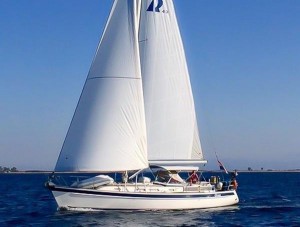48 Volt Propulsion Challenges
As sailing boat owners turn from diesel engines to battery electric motor propulsion systems, there have been projects in which the system design is unable to support the power demands of the motor.
This is typically occurring in the 48 volt sector due to the popularity, safety and availability of products in this well established market. It is important to note that the problems tend to occur when propulsion systems higher than say 20 kW (26hp) are powered from a 48 Volt system.
Lets have a look at this problem.
Recall that Power (Watts) = Volts (V) x Amps (A). For example, a 30 kW (40hp) motor on a 48 Volt battery will potentially demand up to 625 Amps at full load (30,000W = 48V x 625A). Even at 25 kW (33hp) the maximum current will be around 417 Amps.
Whilst from a motor perspective this is technically achievable, supporting these higher currents is challenging from many aspects that are often only considered well into the project. These aspects include; cabling requirements, connector current ratings, fusing, the ability of the battery (and the cells that form the battery) to support this current, both electrically and thermally, battery capacity, as well as other safety aspects that exist as a consequence of these higher currents.
This is a relatively complex challenge to develop a reliable solution, clearly demonstrated by the number of projects that result in battery electric propulsion systems that are not the viable propulsion alternative that was hoped.
The Pattern of Disappointment and Frustration
In our experience there is a pattern of disappointment and frustration, that while seeming completely logical, ultimately leads to a poor electric propulsion solution, and it is usually follows as a variation on this theme;
- source motor at required power
- supply battery and system
- battery or system, does not perform as expected due to the higher currents (range disappointing, but this comes later)
- include additional battery in parallel to reduce currents at each battery (which appears to also resolve the failure in range expectations)
- challenges in finding suitable on-board charging systems to support longer range requirements of electric motors for continuous operations.
Getting the system to this point is an expensive exercise, and the interesting aspect of this is that the application of apparent sound logic to the design has not provided an effective outcome.
48 Volt Solutions
In order to provide robust battery electric solutions, m-powered.global caps the 48 Volt systems to less than 20 kW (26hp) motors. This can be further broken into two types of power ranges; the 6 - 10 kW (8 - 13hp) range, and the 10 - 20kW (13 - 26hp) range.
The 6 - 10 kW range is for smaller sailing boats and can be operated from a 48 Volt module with maximum current of around 200 Amps, which is a very manageable maximum current in terms of battery load and current carrying components.
The 10 - 20 kW range is for larger sailing boats, typically up to around 35 feet, depending on hull design. These systems have a maximum current of around 416 Amps. These higher current 48 Volt systems are configured as two, 48 Volt modules that are paralleled with a Power Distribution Unit (PDU). This ensures the higher currents of these systems do not expose the battery modules to currents higher than around 200 Amps. The PDU includes safety systems that protect the batteries during hydro-generation.
Hydro-generation is the ability for an electric powered propeller to charge the battery while under sail and is a valuable source of energy.
Solutions for Larger Propulsion Systems
The solutions to larger electric propulsion motors in the 25 - 60 kW range for sailing yachts in the say, 30 to 55 foot class is to reduce the electrical loads by increasing the battery system voltage.
Recognising this, m-powered.global has introduced the 144 Volt system which supports higher powered motors at reduced electrical currents. At this higher voltage the 25 kW motor has associated maximum current of just over 170 Amps, while the 60 kW motor has a maximum current of 416 Amps, which is shared in parallel packs and a PDU.
The 144 Volt system provide a useful voltage between the 48 Volt systems and much higher voltage systems of around 350-600 Volts and is an excellent solution for sailing boats requiring motors in the 25 – 60 kW range. The 144 Volt systems are sophisticated saildrive systems that support hydro-generation.
Tech Notes are a technical comment on a particular topic. Tech Notes are provided as guiding information only and are not to be relied upon as technical advice. Please check our White Papers for more detailed information on this and related subjects.

